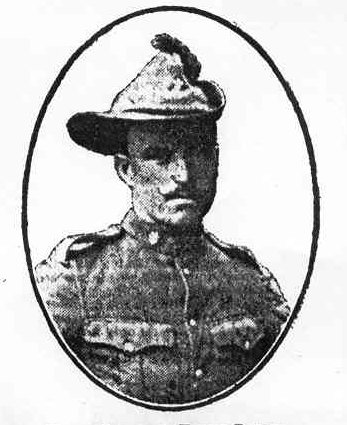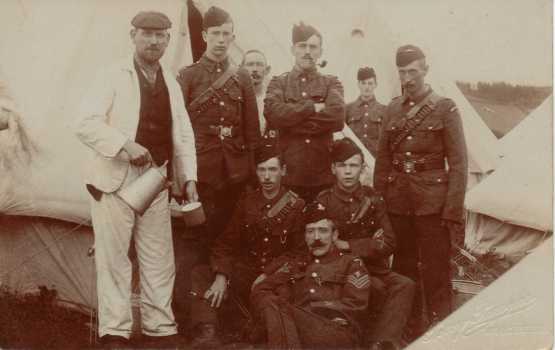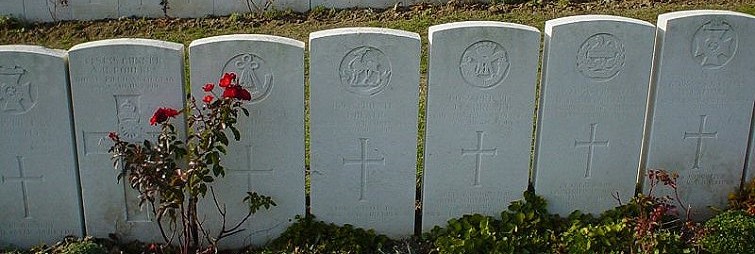 1st Battalion Worcestershire Regiment
1st Battalion Worcestershire Regiment
9584 Died of wounds 8th March 1917
Harry Darkes is not only a member of an extensive Bewdley family, but he is also
one of the soldiers on the St Anne’s memorial with the best-documented military
careers. He served in the Boer War before being killed in the Great War.
Henry ‘Harry’ Darkes was born in June 1877, the son of Thomas and Jane Darkes of
Lax Lane Bewdley. 1 Thomas Darkes was a casual labourer and was born in
Bewdley in 1847. Jane was also born in Bewdley in the same year. In 1881, the
family lived at Court Number 1, Lax Lane. Harry Darkes is a four-year-old, and the
family includes Edith aged 12, Leonard aged 10 and 2-year-old twins Ann and Mary.
By 1891, the family were at 40 Lax Lane, and had been joined by 6-year-old Kate,
Thomas aged 4, and Frederick aged 1. Harry was now 14 and employed as an
errand boy.
On 10th January 1900 attested for service in the South African War. At some point
previously joined 1st Volunteer Battalion of the Worcestershire Regiment, the
Bewdley company volunteered for service against the Boers en masse. Darkes’ trade
is a painter, age 24 years and 7 months, and his father Thomas’ address is 40 Lax
Lane.
Harry served as part of the detachment of troops sent from Bewdley to reinforce the
2nd battalion Worcestershire Regiment, led by their officer the then-Lieutenant Robert
Henry Whitcombe (see appendix). The 2nd Battalion had embarked on the troopship
‘Tintagel Castle’. They arrived in Capetown on the 8th January 1900 and made their
way north to the town of Rensburg. Along with 2 other Battalions (2nd Wiltshires and
1st Royal Irish) they joined General Clements’ brigade, defending a semicircular
position near Slingersfontein which extended across nearly fifty miles. On the 12th
February 1900 three Worcestershire companies position on a kopje came under
ferocious attack by Boers commanded by general de la Rey. Some forward positions
were overrun, but the Worcesters kept up sufficient fire to make further advance by
the Boers impossible. The Worcesters lost their commanding officer, his second in
command and over 200 killed and wounded in this engagement. Harry Darkes was
posted to the Regiment on the 23rd February 1900 and may have been part of
reinforcements after this engagement. By the end of his service in the Boer war in
June 1901, Harry Darkes was a Lance Corporal, and his service is recorded on the
Bewdley Boer War memorial in the Town Council chambers.
Harry Darkes seems to have returned to Britain at the end of 1901. He became a
reservist attached to the 1st Battalion, in line with established practice. Soldiers
leaving active service could expect to be recalled in time of war. He returned to
Bewdley, and in 1911 was again living with his parents in Lax Lane and was a
painter by profession, and he played football with Bewdley Victoria Football Club.
With the outbreak of war in August 1914, Harry Darkes was quickly recalled to his
regiment. He was mobilised on the 8th September 1914 when his height is described
as 5 feet 61/2 inches tall, his physical development is ‘good’, and his ‘complexion
‘sallow’. He was based at home until 24th November 1914, when he joined the 1st
Battalion in France in the Neuve Chapelle / La Bassée area. (See the service of Pte
Thomas Bishop above) The 1st Worcesters were then part of the 24th Brigade of 8th
division. Darkes resumed his previous rank quickly, being made an acting unpaid
lance corporal on the 11th December 1914.
Darkes was first wounded on the Western Front at La Bassée on 7th January 1915:
this was a period immediately after the 1st Battalion’s trench raid described by Private
Walter Bow (see above). The Battalion were still at Neuve Chapelle near hamlet of
Petit Logis, and in a letter published in the Kidderminster Shuttle, Darkes describes
how close a sniper came to killing him:
It made a parting in the middle I can tell you and struck the bone. Had it been a
quarter of an inch lower I should not have been here to write this. I lay in the
trenches all night after I was wounded, and it was awfully cold. The rain poured
down in torrents and the bullets were flying round us; it was like hell itself. The
enemy’s trenches were only about one hundred yards away from where we were.
We had been in the trenches three days and nights, with the water up to our
middle…the strain of fighting day after day, the guns, and the work in the trenches
is very severe. Kidderminster Shuttle 23rd January 1915 p.7
Darkes was taken to Boulogne and then by the hospital ship St Patrick to London’s
University college hospital in Gower Street, where he was treated from the 13th
January to the 23rd January 1915 with sepsis in a bullet wound to the head. While
convalescing, he was promoted full Lance corporal on the 26th march 1915, and he
returned to his unit on the 2nd May 1915. He was promoted to unpaid Corporal on the
10th May 1915. For the remainder of 1915, the 1st Worcestershire saw action at the
Battle of Aubers Ridge in May, and the action at Bois Grenier, a diversionary attack alongside the Battle of Loos in September. He was made a full Corporal on the 6th March
1916, and had leave in England at the beginning of May.
By the time of the major British assault of 1916, the attack by Rawlinson’s Fourth Army on the Somme, the 8th Division formed part of III Corps. While the 24th brigade and the 1st Worcesters did not take part in the cataclysmic first day on the 1st July 1916, they
listened to gunfire in their billets before being ordered to move forward.
They were to be part of the effort to take the fortified village of Contalmaison. 24th Brigade moved forward with difficulty through a complex of crowded trenches, some newly seized from the Germans. ‘B’ and ‘C’ companies (Harry Darkes was in ‘C’ company) were at the front in a captured German trench called Shelter Alley with ‘A’ and ‘D’ companies as a reserve. To the right, along the adjoining Quadrangle Trench were 2 battalions of 52nd Brigade, the 10th Lancashire Fusiliers and the 9th Northumberland Fusiliers. Unknown to the Worcesters, the Germans were preparing a counter-attack at the same moment.
The British opened their attack at 1.30 am on the morning of the 7th July. Half an hour
later the two 52nd brigade Fusilier battalions attacked but were halted by heavy machine-gun fire; despite this, some 10th Lancashire Fusiliers reached the German held ‘Pearl Alley’ trench and even the village of Contalmaison itself. At the same time, ‘B’ company of the 1st Worcestershire made their way forward to the trench junction with Pearl Alley at dawn. At this very moment, they met the German counter-attack – the remains of the 10th Lancashire and the Worcesters fought a vicious half hour battle to hold their positions. It was obvious that Contalmaison could not be taken until the 52nd Brigade attack from Quadrangle Trench was successful. The 9th Duke of Wellington’s and the 12th Manchesters attacked at 8 am with bombing support from the 1st Worcesters. While initially successful, the 52nd brigade was driven back by a German counter-attack, with the Worcesters helping to stem the enemy advance with bombs.
The situation was complex and obscure to the British high command. Orders came for
the 24th brigade to attack the southern end of Contalmaison. ‘B’ and ‘C’ companies of the
1st Worcesters attacked from ‘Pearl Alley’ at 10 am. Despite heavy machine gun fire they
reached the houses of the village and fought hand to hand to capture Contalmaison up to
the fortified ruins of the village church. At 11 am Darkes’s ‘C’ company came up on the
right of ‘B’ company, which led to yet another German counter-attack which was again
repulsed by hand to hand combat. It is the attack at 11 am that Darkes seems to describe
in a letter to his brother printed in the Kidderminster Shuttle:
I am contented to think I am out of the roar of the guns…you could fairly feel the
ground rock beneath your feet and the poor devils who gave themselves up didn’t
seem to know what they were doing. Some of our own men went mad through it, let
alone the Germans. I am afraid we lost a lot of our battalion…we made two charges
but retired as they had so many machine guns fixed in the old house and the church
and nothing could live under it. We had the final at night. How we got there I don’t
know. I heard the order to get over and that is all…I had just got over when I felt
something sting across my forehead and felt the blood running down my face and I
had to come out, but I was in time to hear the Allemand (sic) shouting ‘Kamerad’ as
our chaps got to work with the bayonet… Kidderminster Shuttle 22nd July 1916 p.7
Darkes was out of the fight at this time, but the battalion’s misery went on. The
weather broke, and the 1st Worcesters were unable to bring up sufficient
reinforcements to hold their positions in Contalmaison. By the afternoon of the 8th
July, German attacks forced the Worcesters back to Pearl Alley, with the survivors
being withdrawn to rest positions in Crucifix Trench. Another attempt on the village
was made later in on the 8th July, but Contalmaison did not fall until an attack was
made from its western flank by another unit two days later. The 1st Worcesters lost 5
officers and 32 other ranks killed, and 8 officers and 213 other ranks (Including Harry
Darkes) wounded.
Darkes was taken to 38th CCS also at Bray, then ambulance train and hospital in
Boulogne. He returned to his unit after retraining on the 16th September. He was
again wounded in action on the 27th October 1916 during fighting for the Transloy
ridges in closing stages of the Battle of the Somme, in fighting to seize Grease
Trench near Gueudecourt. He was taken to the 48th CCS on 28th October, then
eventually to a hospital in Etaples. He rejoined his battalion on 1st December 1916. He
was treated in hospital for muscle pain at the end of January and the beginning of
February 1917; perhaps understandable for a man in his early 40s, feeling the stresses
and strains of continual battle.
By this time the 1st Battalion continued operations in the Somme valley, particularly in
the valley through the villages of Moislains and Haut Allaines. German positions
dominated the western heights of the valley, especially near the village of
Bouchavesnes. On the 4th March 1917, the British attempted to storm these positions
with a heavy artillery barrage.
The 1st Worcesters attacked in the centre, with the 2nd Northamptonshire on the left.
The right flank of the Worcestershires was the road from Bouchavesnes to Moislains;
south of the road, the 2nd Royal Berkshire continued the front of attack. The German
front line was overrun, and the 1st Worcesters also seized their further objective in
‘Fritz’ trench, capturing a German machine gun in the process. The battalion also
took control of the German third line, before falling back to Fritz trench, and prepared
the position for a counter attack. This was heralded by a heavy German barrage, and
German troops fought strongly to retake their positions using hand grenades. The
battalion successfully kept the attacks at bay with strong Lewis gun fire. They were
relieved by the 2nd West Yorkshire, and the 1st Worcestershire withdrew to positions
in the rear near ‘Asquith Flats.’ Nearly all of the casualties were from German shell
fire. 6 officers and 44 men were killed, and Harry Darkes was amongst the 4 officers
and 358 other ranks wounded. The regimental history notes that the day after the
attack was marked by a heavy snowstorm.
Harry Darkes died of wounds in the 48th Casualty Clearing Station based at Bray-Sur-Somme on 8th March 1917. He was buried in the cemetery attached to the CCS
which is now Bray Military Cemetery. This is to the north of the village, a little west of the
road to Maricourt His grave is in plot II. D. 35. His personal effects were sent to his
fiancé Fan Lancett. On the anniversary of his death in 1918, his family published a
poem in the Kidderminster Shuttle:
One of the best that God could lend,
A loving brother and faithful friend
We miss him and mourn him in silence unseen
And dwell on the memories of days that have been.
Sleep on, dear brother, in your distant grave,
Your life for your country you nobly gave.
No friends were near you to say good-bye –
But in God’s keeping now you lie.
(Silently mourned by his mother, sisters and brothers)
Another memorial notice in the Shuttle reads: ‘Lovingly remembered by Fan’





